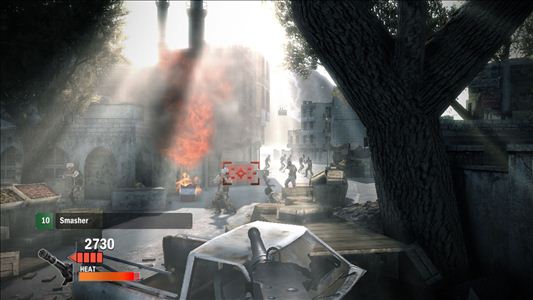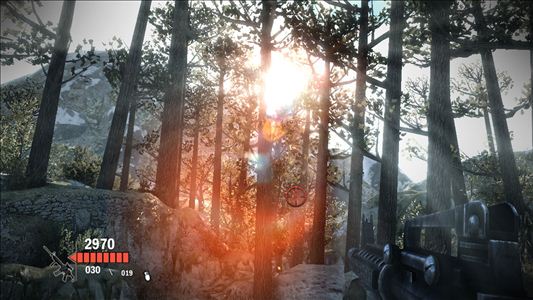Easy-to-grasp arcade action; unlockable gameplay perks; four-player cooperative mode
Weak enemies until Veteran Mode; lack of weaponry choices; bland story
Following Heavy Fire: Special Operations and Heavy Fire: Black Arms, Teyon continues its on-rails light gun shooter series with Heavy Fire: Afghanistan. It’s all there in the name, really– you’re under heavy fire, and you’re in Afghanistan. What is there for a gung-ho Marine to do but to shoot people all day long? (Answer: Not much, and I like it that way.)
While Heavy Fire: Afghanistan does have a story– basically, the player character’s been working his whole life to become a Marine, and after becoming one he goes to Afghanistan– the game is really all about shooting people. And what a great many people there are! Two difficulties and twelve stages await the player, in varying locations: the desert, a cave, terrorist hideouts, the works. And while there aren’t really specific types of enemies– you’ll see two over and over again, those two being Man With a Turban and Man with Blue Hat– there’s just enough to whet your trigger finger’s appetite. Sometimes you’ll mix things up with Man in Pickup Truck, too, or Man on Turret. Regardless, the objective is simple: point your Wii Remote at the screen and press B over and over until all enemies on the screen are dead. (Except when you’re in a turret, in which case you hit Z to shoot out missiles over and over again until all enemies on the screen are dead.)
Unfortunately, unlike games like Resident Evil: Umbrella Chronicles or The House of the Dead: Overkill, Heavy Fire: Special Operations has enemies that are rather challenged in the endurance department. Although I started off the game much in the same way that anyone would– I held down the B button on my machine gun until the enemy fell down– I soon learned that only one bullet was needed for every single human enemy in the game, and adjusted accordingly. This means that while you can certainly waste all the ammunition in your machine gun, forcing you to switch to the infinite-ammo pistol, it won’t do you that much harm. Unless you’re facing an armored vehicle, you’ll still be able to down enemies in one shot each.

Point and shoot, that’s all you’ll want to do.
Now, this might sound like a terrible game-breaker– and, to some extent, it is– especially since you’re in the game with a whole platoon of Marines. (You’re not Master Chief, all right?) But actually, it’s odd how your friends and your enemies ever became Marines and terrorists to begin with, on account of how they have terrible aim. In fact, you’ll probably be the only one actually hitting anything with more than a fifty-percent accuracy rating, even though all the enemies have eyes only for you. Meanwhile, red exclamation marks pop over the heads of enemies that are truly about to hit you, making it easy to pick off who you need to kill first. This is exacerbated by (an admittedly very nifty) cover system, reminiscent of the seminal Time Crisis series, wherein players can head behind a wall essentially anytime to avoid heavy enemy fire when they see those exclamation marks coming. That said, perhaps this is intentional– it gets awfully easy to get in a mindset where you think nothing will happen to you, and then realize that your lack of cover has caused your health to dwindle down to nothing. Those exclamation marks, you see, can come very quickly– especially when you beat Rookie Mode and head over to Veteran.
(It also gets easy to just shoot randomly, thus hitting your useless Marine brothers-in-arms and killing them in one hit too, thus getting you a verbal warning that amounts to 50 points’ reduction. Killing hostages is even worse, and in the cave stages, where everything is really dark– let’s just say that you’ll probably do it more than once. Oops.)

That lens flare sure is pretty, but I wish I could see what I want to shoot.
In order to avoid that inevitable boredom that may or may not come with on-rail shooters, Heavy Fire: Afghanistan comes with a nice, if simplified, perk system. Every two missions, players have the option to choose between four different perks: extra clips, extra grenades, an improved gun, and faster reload times. And at any time, players can reset their choices and choose something else, which is nice when you max out a branch and realize you don’t want it after all– which is what happened to me. Initially, my love of big guns drove me to grab guns upgrades till I maxed out at the M-249 heavy machine gun; after I realized that one bullet was enough to kill most anything, though, I reset and grabbed lots of extra grenades instead. Unfortunately, this means that an entire branch and possibly more are rather useless in-game. Still, combined with in-game achievements that propel players to higher and higher ranks– you’ll get ’em for long-distance kills or multi-kill combos– there’s a good bit of replay value here, and players in for the long run can go through both Rookie and Veteran difficulties just for that four-star General rank.
Finally, in a smooth move that certain other games (Resident Evil: Umbrella Chronicles, I’m looking at you) rather overlooked, Teyon’s latest shooter supports multiplayer for up to four players. Enemies, however, don’t get any stronger, making the game really more competitive than cooperative, a shooting gallery rather than a desperate race to smash some terrorist plan. (It also makes the chances of success for Marines and hostages even worse considering the on-screen carnage.) This makes Teyon’s addition of a local leaderboard a nice one– each player can make his or her own profile for eternal posterity on the Wii console. Online leaderboards, too, would have been nice, though not wholly necessary. Presumably the point here is to have fun and compete with real-life people, and that’s good enough.
Heavy Fire: Afghanistan has its problems: weak enemies, pointless perks, and threadbare storyline. But people will play this game because they want to shoot things, possibly with friends, and Teyon has made a game that does that well– and budget-priced, too.
Nintendojo was provided a copy of this game for review by a third party, though that does not affect our recommendation. For every review, Nintendojo uses a standard criteria.




 ShareThis
ShareThis






